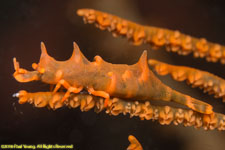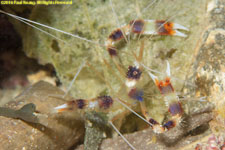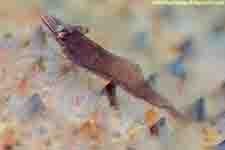 Brownstripe hydroid shrimp, Rapipontonia paragalene
Brownstripe hydroid shrimp, Rapipontonia paragaleneWe took an underwater photography trip to the Philippines in December 2016. We returned in November 2024.
NOTE: We are not experts on these animals; if we have misidentified an animal or if you can identify one we could not, please email us and we will correct it.
Shrimps are decapod swimming crustaceans. Shrimps have thin fragile legs which they use primarily for perching.
 Brownstripe hydroid shrimp, Rapipontonia paragalene
Brownstripe hydroid shrimp, Rapipontonia paragalene
 Graceful anemone shrimp, Periclimenes venustus
Graceful anemone shrimp, Periclimenes venustus

 Translucent gorgonium shrimp, Manipontonia (Periclimenes) psamathe
Translucent gorgonium shrimp, Manipontonia (Periclimenes) psamathe

 Holthuis' anemone shrimp, Ancylomenes holthuisi
Holthuis' anemone shrimp, Ancylomenes holthuisi

 Sarasvati anemome shrimp, Periclimenes sarasvati
Sarasvati anemome shrimp, Periclimenes sarasvati

 Magnificent anemone shrimp, Ancylomenes magnificus
Magnificent anemone shrimp, Ancylomenes magnificus
 Dragon shrimp, Miropandalus hardingi
Dragon shrimp, Miropandalus hardingi
 Anker's wire coral shrimp, Pontonides ankeri
Anker's wire coral shrimp, Pontonides ankeri

 Long-nosed rock (Donald Duck) shrimp, Leander plumosus
Long-nosed rock (Donald Duck) shrimp, Leander plumosus

 Popcorn shrimp (Ambonian , squat), Thor amboinensis
Popcorn shrimp (Ambonian , squat), Thor amboinensis
 Black coral shrimp, Pontonides unciger
Black coral shrimp, Pontonides unciger
The banded coral shrimp is a shrimp-like decapod found worldwide in tropical and even some temperate seas. It is a cleaner shrimp.
 Banded coral shrimp, Stenopus hispidus
Banded coral shrimp, Stenopus hispidus
Harlequin shrimps feed on starfish.
 Harlequin shrimp, Hymenocera elegans
Harlequin shrimp, Hymenocera elegans
 White-headed (mushroom coral) shrimp, Periclemenes kororensis
White-headed (mushroom coral) shrimp, Periclemenes kororensis
Coleman shrimps live symbiotically with sea urchins. They have hooks on the ends of their walking legs to attach themselves to the spines of the sea urchin.
 Coleman shrimp, Periclemenes colemani
Coleman shrimp, Periclemenes colemani

 Sea star shrimp, Periclimenes soror
Sea star shrimp, Periclimenes soror
 Leopard crinoid shrimp, Laomenes pardus
Leopard crinoid shrimp, Laomenes pardus
 Leopard crinoid shrimp, Laomenes cf. pardus
Leopard crinoid shrimp, Laomenes cf. pardus
 Spotted soft coral (Xenia) shrimp, Alcyonohippolyte maculata (commensalis)
Spotted soft coral (Xenia) shrimp, Alcyonohippolyte maculata (commensalis)
©2016, 2017, 2024 Mermaid Underwater Photographic. All Rights Reserved.
Contact us at mermaid@underwater.org.
Last modified 11 December 2024